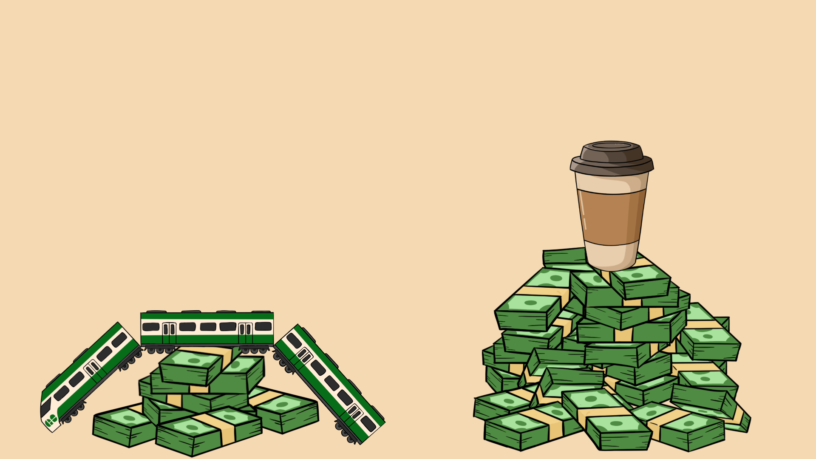By Krishika Jethani
As coffee prices continue to increase yearly, so will the amount students spend on simple luxury items. Let The Eyeopener guide you through why students may allocate more than they should on beans, water and steamed milk.
THE SCENARIO
Take Zayneb Al-Hantoshi for example, a fourth-year biomedical science student at Toronto Metropolitan University (TMU). Al-Hantoshi used to spend around $15 to $20 a week at coffee shops but has now switched to making coffee at home.
Her coffee drinks cost $3 to $7, four times per week, and would sometimes cost more than her transit fare.
So why has the cost been increasing, and how can students better invest their money?
THE NEED FOR EVERYDAY LUXURIES
Nikola Gradojevic, a professor in the Department of Economics and Finance at the University of Guelph, says specialty coffee storefronts have become a staple in many students’ lives as it gives a sense of familiarity.
“[Buying from coffee shops has] become a lifestyle component—which is part of student’s social lives,” he says. “It’s integral to student lifestyle, and you don’t see it differently.”
Gradojevic says buying coffee provides a steady routine for students.
“It’s a relatively inexpensive luxury, meaning it’s an escape,” says Gradojevic. “When the economy is not doing well, and [students] cannot travel much and have these more expensive experiences, you have your cup of coffee in the morning and feel better about your part of the world.”
THE INCREASING COST OF JAVA
According to the Canada Consumer Price Index, the cost of coffee and tea manufacturing increased by 27 per cent over the past two years.
Gradojevic emphasizes the cost of other products put into specialized drinks.
“Specialized [coffee] drinks use sugar, honey and syrups of all kinds. The price of those products has gone up over the past two years. That also increases the price of coffee,” he says.
According to the World Economic Forum, the price of sugar alone has been at its highest since 2011 due to unusual dry weather in Asia’s sugar producing countries and the war in Ukraine, among other issues.
Peter Boxall is a professor in the faculty of agricultural, life and environmental science at the University of Alberta. He says coffee is a costly resource in addition to inflation and increased minimum wage.
“When there’s a hiccup in the tropical parts of the world that are coffee producers, that translates through to the price signals,” says Boxall. “Consumers in China are switching from tea to coffee, which puts more stress on the coffee supply.”
Increased wages and market inflation also factor in the rising cost.
Graham Dobbs, a senior economist at The Dais research group, says inflation and wages work closely together. If the prices of goods and services soar, the cost of living also increases for everyone.
“Although a minimum wage increase is good [for students] in the short term, an overall wage increase tends to put pressure on employers and businesses, and therefore, these increased costs of doing business will be passed on to the consumers,” says Dobbs.
Ontario’s annual inflation rate was 3.99 per cent in 2023. Moreover, the province increased their minimum wage by 6.8 per cent from $15.50 to $16.55 per hour on Oct. 1.
He further explains that a price rise signals some setback in the economy. For coffee shops, factors include labour shortages in the production or the supply chain of coffee ingredients.
Mos Mos Coffee, located at 655 Bay St., raised its prices twice last year, according to shift manager Aimee Lui.
She says the first menu increase was an average of 30 cents and the second by 10 cents due to the increased minimum wage in October.
“Wages and paying employees is the most expensive part of running a business. That affected us as we didn’t let go of any employees [when wages increased], so we needed to find a way to balance and make up for that cost,” she explained.
Many players in the coffee industry are switching to Fairtrade beans as well, and Boxall says students will pay more.
Boxall was part of a research project investigating whether ethical consumers care about price—including paying more for Fairtrade coffee.
“We adjusted the relative price differences between Fairtrade and non-Fairtrade coffee [in a University of Alberta campus coffee shop], and we were able to show that the consumers in the student union building were willing to pay more for the Fairtrade coffee.”
However, he says students may have other sources of income or be in better financial situations. Some students have jobs, and others may live at home, allowing them to spend more money on coffee.
“You can’t lump all students in a basket and claim that they’re similar because that just simply isn’t the case…it depends on the circumstances each individual faces,” he says.
THE SOLUTION
Yi Feng, an associate professor in the Department of Finance at TMU stresses the importance of saving.
“Make a spreadsheet and then try to make a list of your income, the monthly maximum you can receive and monthly spending,” says Feng. “If you don’t find the needs will be met, then make an adjustment and stick to your budget or planning throughout the years.”
If students have extra funds, they can buy luxury drinks to reward themselves, she adds. Students in their early twenties have the advantage of a “long horizon” to save towards retirement.”
Feng says students have the advantage of time to save for their retirement goal with compounding interest in investments year over year.
“There are three important elements in financial planning: the investment horizon, the investment return, and the amount of periodic contribution,“ she says.
Gradojevic views buying takeout coffee as putting money into a non-essential item where there is an investment opportunity.
“If you use your $5, or whatever you spend every day on coffee, and buy [coffee corporation] stock for instance, it will grow significantly over time, assuming [the company] will still exist in 20 years,” he says. “You can generate like $20,000 at least over the next 20 years if you only invest $5 everyday…as opposed to spending $5 with no return.”s
According to the NASDAQ stock market index, coffee-related investments are safer as the industry has experienced sustained growth over decades.
“My main message is small habits will have a huge consequence in the future,” says Feng. “Making wise decisions is something the young generation should think of.”











Leave a Reply